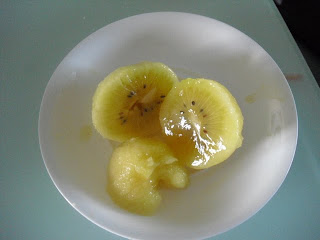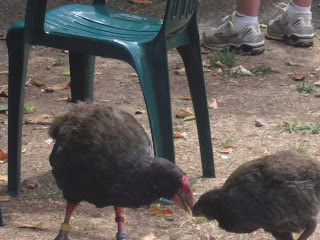The Kiwi
Originally known as the Chinese Gooseberry, the Kiwi was rebranded by New Zealand farmers for marketing reasons. We've been eating a lot Kiwis. Here is a Golden Kiwi.
Does Rachel enjoy Kiwis? Of course she does.
Lamb
Lamb is ubiquitous in New Zealand. For instance, Subway Sandwiches offers a lamb sub, and, as mentioned in the eariler food post, there's even lamb flavored potato chips.
Fish and Chips
After hanging at the beach, and working up a huge hunger, what could be better than a big greasy serving of fish and chips? Nothing, that's what. The fish in this picture is gurnard which is a white fish similar to cod and common in New Zealand.
Rachel was so hungry when this picture was taken that even spicy food, the only food that Rachel does not like, would have gotten a thumbs up
Canned Goods
Any similarities between Wattie's Baked Beans, and Heinz English Baked Beans are merely a coincidence. Wattie's is the big name in processed food in New Zealand. From what I can tell, they take popular canned food from abroad, adjust it to New Zealand taste-- which means making it sweeter-- and market it as made in New Zealand. Interestingly Wattie's is owned by Heinz. This means that Wattie's Baked Beans is a knock-off of a popular English food, which is owned by an American company. Globalism is alive and well here in New Zealand.

If New Zealand had a national soft drink (or, as it is sometimes called here, "fizzy drink"), it would be Lemon and Paeroa Soda, otherwise known as L&P. Their slogan is, "World Famous in New Zealand." As the name implies, it is a lemon flavored soda, made with effervescent mineral waters in Paeroa, a small town on the North Island, not too far from Auckland. It's not as sweet as most soft drinks, and the lemon flavor tastes real.
Does Rachel like it? What four year old doesn't like soda?
Kumara potato
The kumara is incredibly important in New Zealand not only as a food, but also as a cultural artifact. The kumara arrived here with the first Maori canoes, and was an essential staple from the day they landed. The modern kumara is a close relative of the original kumara. One of the great mysteries is how the Maori, and the Polynesians before them, acquired the kumara. Being a member of sweet potato family means they are a New World vegetable. Polynesians and Maori trace their ancestors back to Asia and the Old World. Did early Polynesians sail to South America, or was there some ocean based trade route that people of today do not know about? it's doubtful that we'll ever know for sure.
They are delicious, like a meaty firmer sweet potato, with a skin that cooks up nicely.
As is evident from this post, much of New Zealand cuisine is derived from Britain. Its saving grace is, that unlike Britain, the climate here is hospitable to growing just about anything. A fresh avocado, a plum, or a macadamia nut doesn't require a great deal of kitchen technique to be made scrumptious. A piece of fish, or meat, if it's good enough, just needs to be tended to and not overcooked. Nothing fussy, keep it simple, and let the ingredients shine. That's when New Zealand food is at its best.

















_-group_at_Adelaide_Zoo.jpg)








